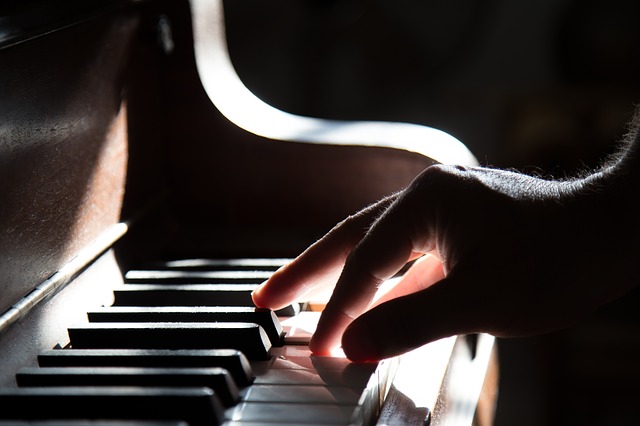Let’s talk about how to learn the order of sharps in music. But first, what exactly are sharps?
Sharps are known in western music as a “diesis” a Greek term which means difference in music. This can mean an accidental or a very small musical interval. But for our purposes, it’s simply referred to as a sharp. To sharp a note means to raise it higher in pitch by one semi-tone. One semi-tone is also referred to as a half step.
So what exactly does this mean in terms of musical information in respect to a specific key? It wouldn’t be very useful without a key signature. Especially in the context of reading a simple lead sheet as many professional musicians do.
A key signature is a specific sequence of sharps or flats placed on a musical staff to the very right of the treble clef. Regardless of whether they contain sharps or flats, they’re always in the same order and maintain the exact same sharps or flats always without exception. They never contain a mix of sharps and flats. It’s either specificallysharps or specifically flats period. 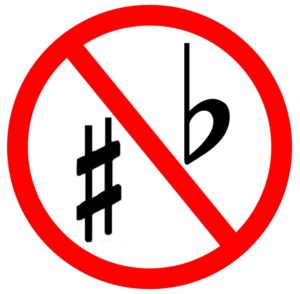
As a side note, it’s very important to understand that you never mix sharps or flats as it refers to a key of music. The reason for not doing so is just a matter maintaining consistency in your understanding of music and avoiding confusion when communicating with other musicians.
So, what does a key signature actually do? It tells us throughout the music whether one or more of the alphabetic notes in music are to be raised or lowered (depending whether there are sharps or flats in the key signature). I’ll cover more on the alphabetic representation of notes in just a moment.
In other words, whenever you come across those specific notes that are listed in the key signature, you’ll play them sharp or flat as the key signature dictates. For example, if there’s an F sharp in the key signature, every time an F comes across the page, you’re to play that note up one half a step. AKA playing the note sharp. You will of course play more sharped notes as more sharps appear in the key signature.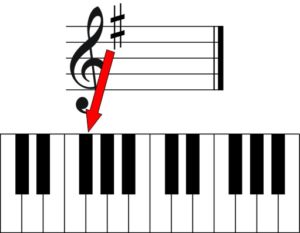
One thing that can make reading lead sheets or other written music difficult, is not having a solid knowledge of the order of sharps. Having a key signature is not very useful if it stops you in your tracks from playing the right notes in a song. So let me reiterate, all sharps in the key signature progress in the same order. Whenever you have a specific number of sharps in a song, they’re actually the same ones in the same order every time.
Today we’re going to cover the order of sharps in music. But before we do, I just need to briefly explain how I’m presenting these sharps on our staff. As you can see, each sharp is represented with a different color. These colors are just simple tools used in the Color Score Visual Chord System. You don’t have to understand how Color Score works in order to understand this article. Just know that each sharp has a different color to distinguish it from one another.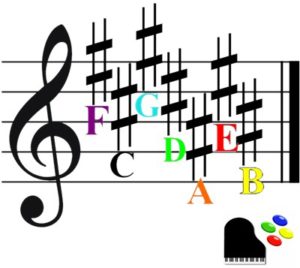
As you probably know, the first 7 letters of the alphabet are represented in every key of music, regardless of whether it is a Major or a minor key. That means no matter of the number of sharps or flats, you’ll always have A,B,C,D,E,F and G contained within every key of music.
Depending upon the key in which you’re in, any one of those lettered notes may have a flat or sharp to accompany it. But, all 7 lettered notes must be present within the key in order for it to be consistent with the music theory, (yea I hate that term also) you can’t skip a lettered note or have the same one twice.
You can’t learn the order of sharps in music unless you’re very familiar with the notes on the staff. I know this is music 101 but I learned long ago not to assume that everyone in the class is on equal footing. So here’s the notes on the staff. Sharps are always placed on the staff line in which the lettered note occurs. For example, if you have a sharp on the line of F in the key signature, you know that the F is sharp.
Sharps are always placed on the staff line in which the lettered note occurs. For example, if you have a sharp on the line of F in the key signature, you know that the F is sharp. 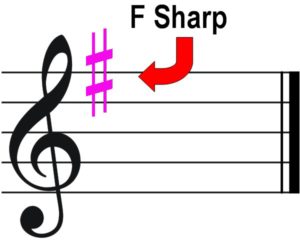
If you see only one sharp in a key signature, then you also know that it’s F sharp. Period. It can’t be anything else. Thank goodness that sharps are never jumbled up in just any old order or the world of understanding music would be very difficult for us musicians.
Here’s the order of sharps in music: F, C, G, D, A, E & B. (7 sharps)
An interesting thing to point out is that with every new sharp that appears in the key signature, a new key of music is represented. Also, those keys of music are just a consistent as the order of sharps themselves. You will always have the same key of music with their corresponding sharps. For example, if you have one sharp in the key signature, you know that the piece of music is in the key of G Major. (always)
I should also mention that minor keys share the same key signatures as their Major counterparts but that’s beyond our subject of how to learn the order of sharps in music today. We’ll cover the relationship of Major and minor keys in another article.
Now let’s put the order of sharps into a better context by placing them in sequence on the staff.
The order of sharps as they appear in context…
F# (the key of G Major)
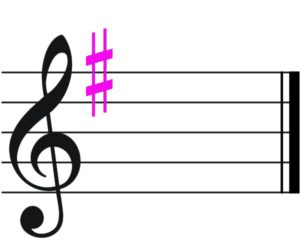
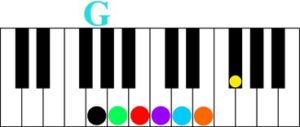
F# & C# (the key of D Major)
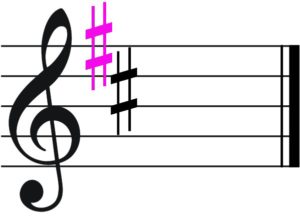
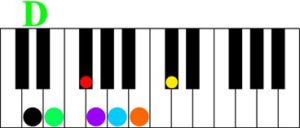
F#, C# & G# (the key of A Major)
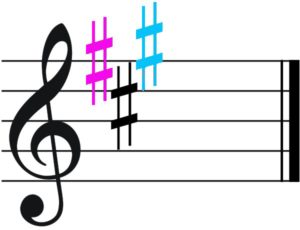
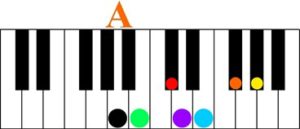
F#, C#, G# & D# (the key of E Major)
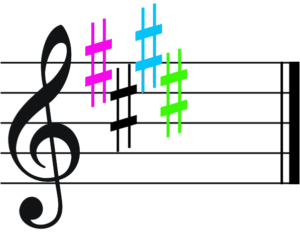
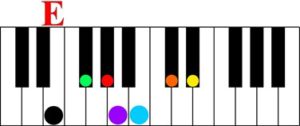
F#, C#, G#, D# & A# (the key of B Major)
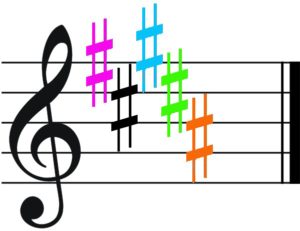
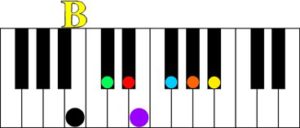
F#, C#, G#, D#, A# & E# (the key of F# Major)
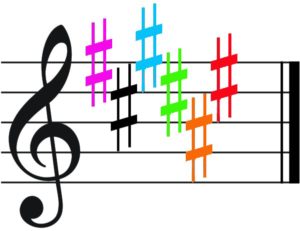
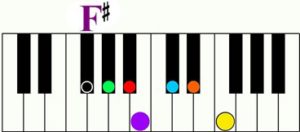
F#, C#, G#, D#, A#, E# & B# (the key of C# Major)
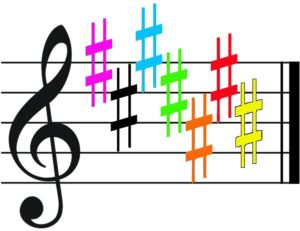
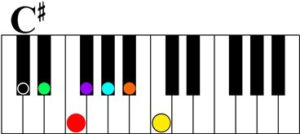
As you can see, 7 sharps is the maximum amount of sharps that you can have in a key of music.
So how do we learn the order of sharps in music? Well, unlike the order of flats, the order of sharps don’t actually spell a word. But, you can use an acronym to memorize the order of sharps.
Try this one: Fat Cats Go Down Alleys Eating Bread.
If you can remember this simple acronym, you’ll never forget the order of sharps in music. You can also create your own acronym to memorize the order of sharps. Just make it something very memorable to you.
That’s it! You now know how to learn the order of sharps in music. But if you want to cement the order of sharps into your brain, download this ‘How To Learn the Order of Sharps in Music instructional guide” from learncolorpiano.com. It’s a free resource and my gift to you for reading this article.
Find out more about Color Score! The easiest way to learn to play the piano like a professional.
Until next time, Go Play!
Greg Lee
Latest posts by Greg Lee (see all)
- What is a minor/Major 7 Chord? - October 26, 2023
- 7 Chord Substitutions that Professionals Use - October 19, 2023
- 5 Simple Chord Tricks to Sound Amazing - October 5, 2023

